

![[GK24 logo]](gk24logo.gif)
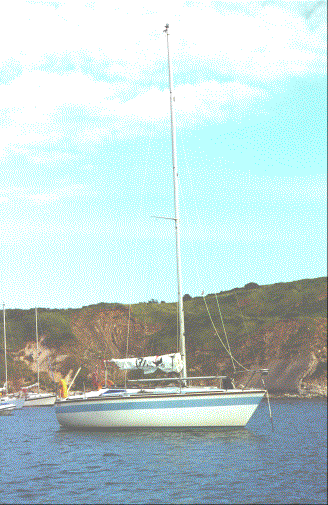
Forethought 2009 log
This is now the story of
year 13 of owning a GK24
Index
Race 1 and 2
Frostbite
Race 3 and 4
Frostbite
Rope off prop
and fitting speed transducer
Race 5 and 6
Frostbite
Since I was made
redundant by NXP
and given a nice payoff for leaving, and managed to get a new job at
Quest Geo Services of Liphook (www.qgsl.com), I decided to spend some
of the money on the boat. On order are new sails and new electronics.
Saturday 10th January - sea trials and refuelling
I took the boat up and down the Hamble using the new Simrad TP22
autopilot but it does not yet seem to be listening to the output of the
GPS for navigation to waypoints. Probably a miswiring or NMEA overload
somewhere( actually RTFM , press the auto option and then nav option
button), lots of identical 4 core cables running around the
place carrying NMEA to and from GPS, speed log instrument,
tiller
pilot and AIS/GMDSS VHF. Coupled to this lot will be a Simrad wind
instrument which will also control the autopilot in one operational
mode.
Royal Southampton Frostbite Series 2009
Race 1 and 2 , Sunday
11th January
Owing to a crowded Ocean Village we were forced to start from Hamble,
where the crew discovered the mess that Eastleigh Council have made of
the parking in Hamble which is not liked by anybody and was not asked
for by the Parish Council. It makes Hamble even more unwelcoming to
people wanting to visit to come sailing or just visit the
village. One crew member took half an hour to locate a space that was
not a pay space so did not have a 4 hour limit on it.
Spaces on the Hamble Common have been 'replaced' by painting car
parking bays and putting up 'P' signs on Spitfire Way where
you
could park anyway.....
We still arrived at the start line after 40 minutes
from the Hamble quay.
This year we started with the same crew as for the Round the Island,
and we raced with the number 2 genoa and and a non-reefed main. Some of
the other boats were using a single reef.. The racing started in
15knots gusting 20 and increased to 20 knots
gusting to the
high 20's. In the first race we flew the spinnaker, and apart from one
from the hatch launch that took a long time to tidy up before we were
able to gybe onto the correct tack for the leg, everything went pretty
smoothly . By the end of the second race the genoa by itself was rather
too large. But we still flew the spinnaker downwind and were
rewarded with 7 knots on several occasions. At least by the
time
we arrived at mark 3, the RIB had managed to put it back in place after
mistakenly removing the mark as class 1 was arriving. It had been used
as the first mark in race 1 and the RIB crew didnt realise it was the
last mark of race 2.
After the race we headed back to Hamble and switched the VHF into AIS
scan mode. Immediately the chart plotter started squeaking as the Red
Jet came up from behind on a collision course. It also squeaked as we
passed stationary oil tankers as some of them were still transmitting
AIS "under way" flags although they were obviously tied up at the time.
Bad boys.
Final approach to the mooring was messed up by the windage causing the
boat to come to a stop broadside on to the wind. It took a fair effort
to put the mooring lines over the cleats.
Race 3 and 4, Sunday
25th January
The night before a set of fronts went through and the wind had dropped
from 28 knots on Bramblemet back down to something we could go sailing
in.
We managed to all get to the quay, the traffic wardens were out at 0830
on a wet windy sunday morning. What used to be a quick park up and get
sailing is now a 20 minute walk from the nearest free parking space.
Les was not around having suffered an ear infection he claims from the
first race, but I did feel then that he was not hearing as well as
usual on the 11th. Anyway we set off in the usual fashion and arrived
at the start line without incident.
Race 3:
As usual we decided to go for a clear-air start at the pin end of the
line and this time there was several forces different in the wind
strength between each end of the start line. The wind was
very
shifty and there were big holes all around the course. We crept across
the line while all the other boats shot away in a gust. The course was
a zigzag across Southampton Water. A few ships passed up and down while
we were racing and this was to be our final straw later on in the race.
Snapped Shackle
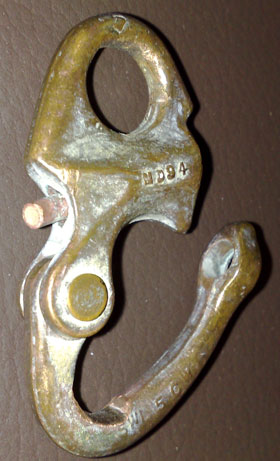 On one tack as we were coming onto the layline for a windward mark, the
bronze snap shackle holding the bottom of the mainsheet on the
traveller (quick release for cockpit living in harbour and use as a
crane hook) got twisted around the traveller and was opened
and
then the
operating pin was snapped off. Fortunately, I had left a couple of
shackles close to hand inside the cabin.
On one tack as we were coming onto the layline for a windward mark, the
bronze snap shackle holding the bottom of the mainsheet on the
traveller (quick release for cockpit living in harbour and use as a
crane hook) got twisted around the traveller and was opened
and
then the
operating pin was snapped off. Fortunately, I had left a couple of
shackles close to hand inside the cabin.
But we still lost ground and had to do a tack to get back to
the mark.
We sailed some distance with Duncan holding the mainsheet and Steve
fitting the shackle.
We had the No1 genoa up because of the light conditions
around
the start - it caused some grief with stiff hanks, and we were
overpressed most of the rest of the race.
On the final beat, we had the RFA Eddystone ship coming in from the
Solent, a container ship of about 60000 tons coming down from the docks
and a Red Funnel ferry coming in fast from the Solent. We lost about 5
minutes as we could not sail a proper course to the mark, going behind
the container ship and the Red Funnel and in front of the RFA. On the
run back to the finish, Steve put the spinnaker on
upside
down (last done in 2000 in a Frostbite Series race ... ) and we decided
things were too far gone so we decided to
retire being thoroughly last and needing to sort things out a bit
before the next start .
Race 4
We changed down to the number 2 around the start time and this time
once the Class 1 had got going with a big windshift messing up their
start causing a late postponement, we got away and things went well
until near the end when we sailed into a hole, and spent a lot of time
crawling at 3.5 knots instead of 5 to windward and 7 off the wind.
Again it took a long time to get to the finish. We had then got three
soaking sails although the No1 was only damp, the spinnaker was
dripping and the No2 was running wet. I put on the heater and pumped
about 2 gallons of rainwater out of the bilge, dumping it in the sink
which then blocked. I managed to clear it by applying suction from one
of the syphon pumps which I use to clear the bilge. I thought that
would be the worst thing . We dropped Duncan and Nigel off on the quay
, and went to the mooring, But when we got to the mooring things went
wrong. The first mooring line went on the stern cleat OK, after we had
approached the mooring going astern. The second somewhat longer backup
line demanded by the insurers managed to
wrap itself around the rudder and then despite remembering to put the
engine in neutral, it seems to have been knocked into astern. It
succeeded in wrapping the spare line round the prop. I asked for the
engine to be turned over in gear with the stop lever pulled out to
unwind the twisted rope but it started because the stop lever was not
pulled out. A short time later it stopped again. A second set of
attempts working with the engine in gear but not starting unwound the
rope revealing a cut-off end . The rope cutter must have
worked.
The other end of the rope is still firmly attached
to
something on the sterngear - the prop shaft rotates but the rope stays
fixed.
Stockhausen and Burns
Night 31 Jan - 01 Feb
It was a cold Saturday afternoon. I took Catrina out with me to help
move the boat. .We fitted the outboard to the bracket on the stern of
Forethought, but in retrospect,it could have been more
effective
leaving the outboard on the tender and using it to push Forethought
from alongside. The tilt angle of the engine was left correct for use
on a dinghy. The result was we made a small rooster tail , the outboard
throwing water and air. We crept against the wind, it was slack water
so that was not a problem.
Catrina helmed, and I operated the engine , keeping my weight above the
outboard to improve its grip.
We arrived at the Royal Southern piles, just as Shirley and Ashling
walked down to the clubhouse, so after tying up Forethought, with about
0.5 metres of water under the keel, we paddled the dinghy ashore - did
not notice there was only one rowlock before we borrowed the dinghy.
Sat in the bar with a Coke and watched the Fireflies racing out on the
river .
As twilight approached , I collected a load of gear and took it out to
Forethought . I threaded the cable through for the
paddlewheel
transducer up to my new instrument panel. The new sounder
indicated 4.4 feet and then the keel grounded about 1630 . I waited for
the tide to fall clear of the hull - fortunately there is a pontoon
tied alongside the piles , so I could step off and look
without
getting mud anywhere.
I then drilled a pilot hole for the paddlewheel transducer from the
inside of the hull checking for vertical and horizontal clearance under
the shelf where the heads is fitted . I had to take the handle off the
hand drill to get it in. After a lot of slow drilling , it broke
through. I dropped a split pin through the hole because I knew it would
be easier to find in the darkness from the outside.
I prepared a crate of tools and essentials for the job, taking exactly
what I wanted as Hamble mud decontamination is time consuming -
required if you forget anything before going back on the boat to get it.
Two hours later after putting on some old and disgusting
oilies,
I scrubbed the hull with a pad using my disposable gloves that I bought
from an agricultural supplier which go all the way to the shoulder.
(would have made James Herriott's life easier..)
I worked along the hull as the water receded leaving the
usual 2 inches of Hamble mud on the slip.
When I got to the prop I put the gloves to one side, pulled out the
trusty N95 from in my jacket and snapped a picture. The rope
was
wrapped around the shaft between the rope cutter and the P bracket. It
had been cut by the cutter but had then jammed in the gap. As it needs
a gap to allow for the engine mounts to take up when motoring, this
basic rope cutter had reached its limit. After a lot of hauling the
rope came clear , wiggling the prop and heaving.
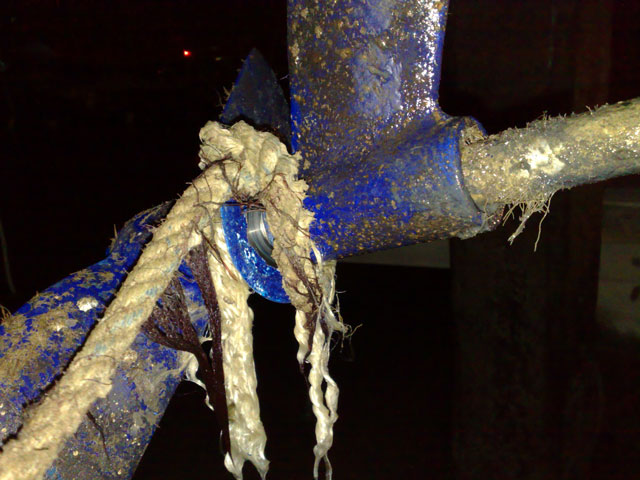
Then I changed to fitting the paddlewheel transducer. Locating the
splitpin I had previously placed, I loaded up the 18 volt Black and
Decker with a 50mm hole saw and blipped the trigger a couple of times.
The drill has a positive lock when the trigger is released , snapping
to a stop. In keeping with the rules of Murphy, the grip of
the
drill was not exactly on the centre of the flats of the hexagonal drive
shaft so when I pointed the drill down after blipping the trigger, the
hole saw fell in the mud. A quick rinse in the river and a wipe with a
rag and I was back in business. I started the saw and was immediately
showered in fibreglass dust. Ugh. I carried on but upwind and after a
few tens of seconds, the saw cut through. I then scraped the antifoul
around the hole back to the epoxy and loaded up the through hull
fitting with Sikaflex which begins life as very sticky so the fitting
stayed put . I went off to decontaminate my boots and salopettes,
especially inside the trousers where the mud seeps. Stomped around on
the pontoon to shed more mud, and went back on Forethought to put the
nut on the through hull fitting. having done that I then had
to
go out , wipe off excess Sikaflex and then dab on a quick bit of
antifouling.
Another decontamination and then that was it.
Job done it was then waiting for the tide to come in. So I
had a
thermos load of chili con carne and rice defrosted and heated
earlier at home. Then to read for a while and play with the features of
the new GPS.
At 2100 I decided to turn off the heater and lie comatose in a sleeping
bag until 2300. So I did that and I dozed and slept for the next 2
hours. I woke up and noticed the happy noises coming from the club
house. I realised that it must be the Burns Night celebrations.
I looked outside and the tide still looked like it had a long
way
to go. So I had a cup of coffee and turned on the
1970's FM stereo. I tuned around and there was someone talking
about Stockhausen on Radio 3 . They played a recent recording, and the
clicks of the heater and the echosounder transducer ,
the squelch
crunching on the AIS channels on the VHF added to the performance in a
strange way . A mystery vessel came up the Hamble and docked
on
one of the outer pontoons at Stone Quay according to the AIS display.
At 0100 or thereabouts Forethought slipped back its keel and I dressed
up in the clean waterproofs and thermals I had bought with me. I took
the boat off the piles. This time I remembered to undo the main halyard
from the piles and tie the dinghy back on Forethought instead of the
pontoon.
I went out and motored around the river for a bit checking for
vibrations - none found so went up to the mooring and tied up at 0200.
While I thought that I did not feel tired , when I found the
heads was not pumping water in at 0220 it made me feel very tired. It
necessitated a partial disassembly of the pump, and then a clean up of
the flap valves, before finally going back in the sleeping
bag
for some sleep.
I wanted to get up again at low water, about 0730 to fit a replacement
for the mooring rope previously mentioned - it is easy to reach the top
of the chain part of the riser at low water to shackle new lines to the
chain. The ebb tide against the wind woke me with the happy chuckle of
water slapping the hull by my head at 0500. At 0730, the air
temperature in the cabin was 4 degrees C before I put the heater on. I
went out, fitted the new mooring rope(3 metres spliced to a
thimble and an eye
splice). All jobs done from that set, I went home.
Race 5 and Race 6 : 8
February 2009
For a change it was cold and calm to begin the day. Only Duncan and
Steve came out this time. We motored out to the start which was delayed
by an hour to wait for the wind which started off as southwesterly on
the west of Southampton Water and southeasterly on the east of
Southampton Water. The topping lift block at the top of the
mast
has completely given way and so we had to unshackle the end on the boom
to get the boom to drop.
On the way out we failed in trying to calibrate the autopilot
-either we went too
fast or turned too fast in the required 540 degree circle, which
mystified other boats around us. A course was eventually set with a
beat of 0.6 miles .
Race 5
We set off from the port end of the line just behind Glass Onion and we
kept clear wind. As we neared Hamblecliff buoy, the windward
mark, the wind started going fluky but we still got round OK.
Occasionally there would be moderately strong gusts but most
of
the time we were sailing under hull speed. We finished with
other
boats for a change. Perhaps the scrubbing of the hull helped..
Race 6
The second race was pretty uneventful apart from the Red Funnel ferry
having nowhere to go while we were going up the beat, and we lost a
couple of minutes tacking behind it. By the end of the race the wind
had increased to about force 4. We finished and went home . It was a
short race. No other problems.
Race 7 and 8 : 22 February 2009
New Sails ! I had ordered some sails from Quantum
before
Christmas and they arrived. On the Saturday before, the whole family
went out to Forethought and Ashling and me fitted the battens to the
new sails. I had ordered a new mainsail, No.1 and No.3 genoa and a
spinnaker. The No.3 has battens as well.
On the Sunday, only Steve could turn up, and there was no wind.
Again on the way out we tried to calibrate the autopilot, and failed
again. I think there may be some other magnetic influence around the
autopilot.
Trying to use the autopilot with control from the GPS resulted in going
off track until the cross track error would compensate for the compass
error and the boat would finally go on course.but 100 metres off track.
As we were playing around in Southampton Water this meant we kept on
trying to ram the tug Thrax that was moored to a buoy 100 metres to
starboard of the direct track to the waypoint I had selected.
There was no wind but it was mild and sunny, and the race
start
was delayed. The result was that when the wind did fill in,
we
only had time for a pair of two leg races, to a windward mark
and
back. There was a good breeze, so we set the new main and the new No.1
but keeping with the old spinnaker because we were short handed and the
new spinnaker bag needs some thought as to how we clip it on.
Race 7
We started a bit late and went out into the deep channel. For a while
we were keeping up but eventually we sailed into a hole in the wind and
slowed right down. In the gusts, we had 5.5 knots on the log, in the
hole about 2 knots.
Race 8
We started even later and the story of the race was much the same.
Interesting examination of the hull core
When I fitted the paddlewheel transducer, I kept the core cut out by
the hole saw and later on I filed down the hull surface at a
shallow angle to more clearly show the cross section of the
surface layers. This was gelshielded 10 years ago and the laminate
seems not to be affected by osmosis still.
From left to right ...
Surface - rough because many coats of eroding antifoul not sanded down.
Dark blue : International Micron
Pale blue : International Micron .
Grey: Antifoul primer
Green : Gelshield
Grey smooth : Epoxy filler
Grey rough : Epoxy filler
Green : Gelshield
White : original hull layup
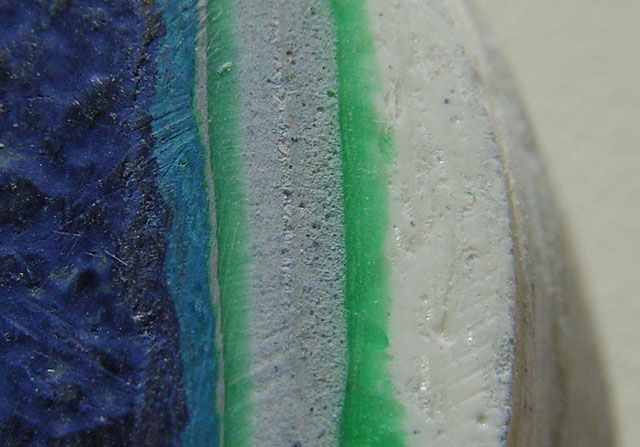
Looking at the same thing side on : the whole antifouling
through to hull layup is about 1mm
Note the pores in the hull layup, some with green Gelshield epoxy in
them- possibly the origin of the osmosis in the first case. The red
stuff is paint from the hole saw.
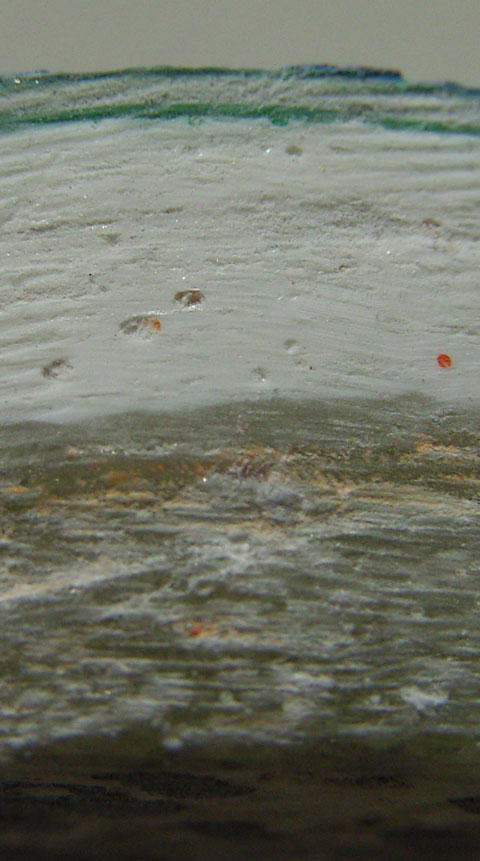
Images courtesy of the 1cm super-macro mode on my Samsung NV-S7 camera
which has a Schneider-Kreuznach lens on it (this company's lenses
normally used for movie cameras). This makes up for the slightly noisy
image sensor and the habit of the viewfinder blanking out at +5C and at
other times when the camera is being heavily used in the middle of
Irish peat bogs.
Race 9 and 10
I had decided to order a new number 2 and a boom cover from Quantum to
go with the new sails. By accepting they would make the sail sometime
over the next 10 weeks I got a discount.
I was slightly concerned we would need the older No.2, although it is
still quite good.
But it turned out to be quite windy. So Steve and myself again were
struggling against the elements, with the new No3 up and a reef in the
main. As it all went up we lost the genoa halyard which took a bit of
catching in the breeze. Then we noticed the second reefing line had
crossed the first reefing line so that we could not
have
reefed again. We managed to fix this then we went racing. At
first we were quite in control of things, and were keeping up with the
trimaran that was racing as they needed to be so careful in the fluky
gusts up Southampton Water. As the race went on we noticed the white
horses were building as the wind blew across the Water (about one mile
fetch) and the sailing got harder. We ended up doing over 7
knots
on a dead run with a reef in the main and the No.3 goosewinged.
At the end of the second race we broached and the boat lay
over
on the run just on white sails. I think we were getting tired.
Back up the Hamble we stopped at the Royal Southern pontoon and cleared
up in the shelter offered by the club buildings. Then off to the
mooring and by this stage the wind was pushing the bow off the
wind so we couldnt come in slowly heading up wind.
We ended up blowing down wind bows first onto the
mooring
with the engine going astern to slow us down . We stopped and then the
boathook bent and Steve dropped it in the river. Fortunately it floated
and he was able to go back and get it about 10 minutes later as the
wind and the tide balanced it quite nicely near the boat.
Hamble River SC Wednesday Evening Series
Race 1: 1st April 2009
I was expecting problems arriving on time on Wednesday evening, but I
ended up attending the Ocean Business show in Southampton on Wednesday,
so I managed to arrive at Hamble in good time.
The usual crew were back , from illness or work so we set out with a
full crew and the new sails for the first time. Despite sailing off to
one side of the course in the hope of finding more favourable tide but
ending up with less wind, we still managed a second place.
Race 2: 8th April : Not Really Racing
This time I was only able to arrive by about 1750 so we decided to go
for an arrangement where the I would give a key to Steve and the crew
would get the boat off the mooring. Unfortunately there was a
miscommunication on leaving the berth, and it was quite a low tide, so
the stern ropes ended up round the propellor again. Fortunately part of
the miscommunication resulted in the boat still being moored at the
bows. So the evening turned into a long and cold session of clearing
rope from the propellor. I did not like the idea of the boat being
moored by the propellor so I felt we had to clear enough rope to make
sure we could leave the boat moored more or less normally,
but
with more or less rope hanging from the propellor.
We started with weight on the foredeck and this brought the propellor
into view. One of the stern mooring ropes came off the prop and so we
had a bow and stern mooring line. So we shifted to using a spinnaker
halyard across to a nearby pile and weight at the bows. A lot of sawing
with a junior hacksaw and eventually we had a lot of pieces of rope and
two shivering people.
There is still some rope on the propellor shaft but the propellor turns
fairly freely, and we have left it as the boat should be coming out of
the water for a 10 year insurance survey and tidy up quite soon. Again
I am glad I changed the P bracket a while back as the old one probably
would have come loose with all this mistreatment.
It looks like some practice in tricks and concepts of leaving moorings
is needed .
Sunday 12th April : Repairing the mooring
Steve and I bought 17 metres of rope and a shackle and
thimble to repair the mooring. When we got to the boat and looked
harder we realised that one of the other riser ropes had been chewed so
needed replacing. So back to the Chandlery Formerly Known as Aladdin
and another four metres of rope and another shackle and a thimble were
purchased. Total cost was about £35. I spliced the ropes and
we worked on replacing the risers, waiting until the tide went out
enough for us to get at the end of the chain. Once that was done we
scrubbed the more easily accesible part of the hull, and went away,
Race 3: 15th April : From wind to zero
I was able to be at the pontoon really early this time , as we had had
a couple of days in London so I was not in work. There was quite a
strong breeze, enough to set off with the Number 2. Early on while
preparing the spinnaker pole on the beat, Les repeated a little skid on
the foredeck and ended up hanging from the spinnaker pole with Steve
hanging on the uphaul keeping him from crashing. We made
reasonable speed but as the wind decreased, we were losing power, but
we just made it around the last windward mark before the breeze died.
With the GPS showing 1.3 knots and the water speed at 2.0knots with the
spinnaker up we decided it was time to change down to the light 3mm
spectra spinnaker sheets, which stopped the spinnaker from collapsing.
We sat around for a while as the opposition either crept off on the
last of the breeze or drifted outside us in stronger tide standing
still over the ground. We were encouraged by the sound of the Class 1
leaders coming through, as they had more wind upwind and inshore of us.
We waited and the pressure came back on as the sun set. Hanging onto
the sheets using water bottles as handles - needs something like kite
string handles to take the strain on the thin sheets, we made it back
at 5 knots through the water, 4 knots over the ground.
Sunday
19th April : Photoshopping the deck
Back in 2001, Forethought looked like this :
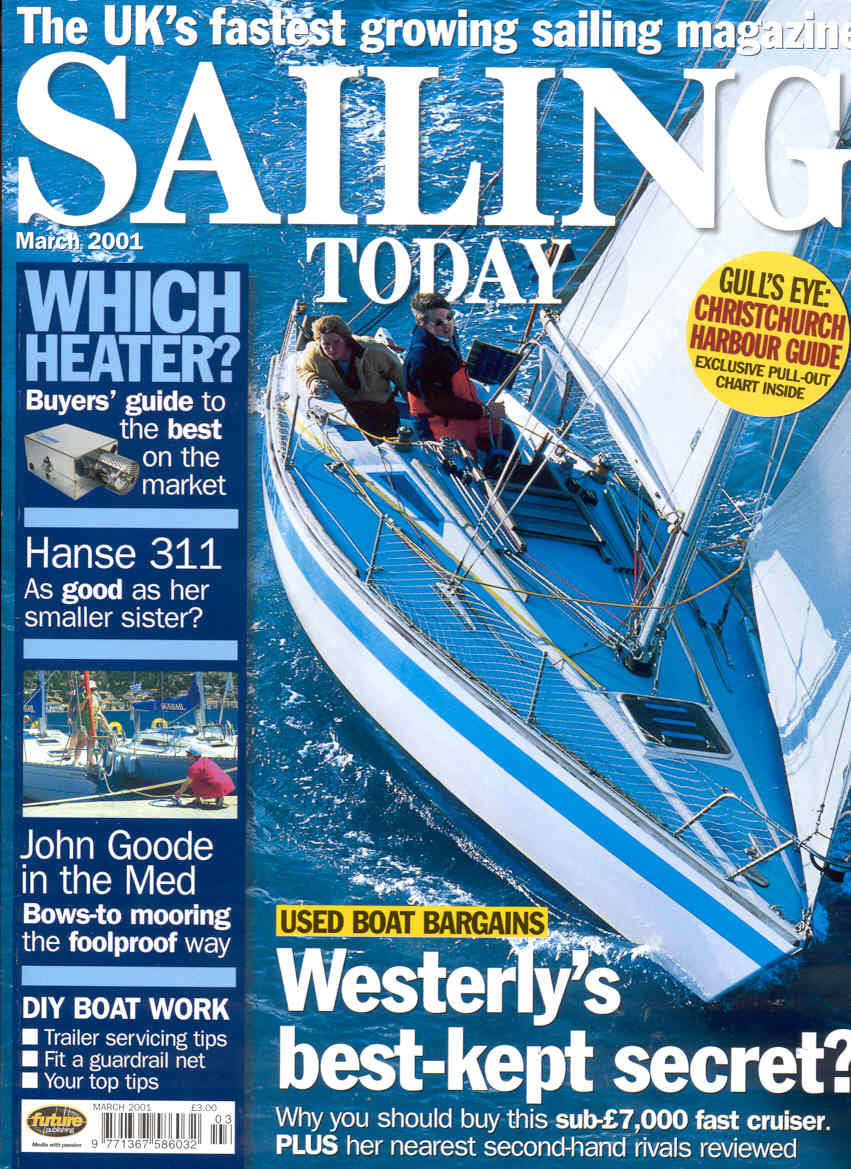
I thought the boat was Photoshopped or equivalent, but then I realised
it had new deck paint. As Les had slipped on the deck in the last race,
and partly this is down to his boots, but some of the slip was due to
the slightly shiny deck.
I spent the afternoon in a cycle of using a Dremel tool to mill out
cracks in the deck, then filler and sanding then paint. In the sun and
wind the water dried and I was able to do the foredeck panel and the
two side panels of the deck before running out of paint and masking
tape and getting bored with the whole game.
Wednesday 22nd April : Committee Boat duty
I tried to leave early from work but the race officer was not able to
wait 10 minutes for me, heading out of the river with only Steve and
another on board. So I went home in disgust. I had tried extra hard to
be early but it probably never will be possible for me to make it on
time.
Sunday 26th April : Beaulieu Boat Jumble
I managed to buy some antifouling paint and a new topping lift for when
Forethought comes out of the water for maintenance including the
replacement of the rigging over a weekend soon.
I collected the new boom cover from Quantum over the weekend.
Some Wednesday races followed but
the performances became more dismal as the weed grew.
But
we discovered that the autopilot now will steer a course to the
chartplotter's command with only a few metres cross-track error. A
major step forward.
Mid-Season haul-out
On
the second May bank holiday, I arranged for Forethought to come out of
the water at the Elephant Boatyard, being near to the Aladdins Cave
Rigging shop. So I did a lightning attack on all of the things that
needed doing out of the water.
Day 1: Thursday :
The tide allowed the family to drop the boat off at the boatyard.
Day 2 : Friday :
nothing done
Day 3: Saturday
Antifouling
scraping, removing vinyl names from the sides and transom (done by
Catrina) using
a scraper and excessive force. Sand remainder of blue stripe on
side of boat. Paint one coat of blue paint over the area where
name was. Paint transom white areas with International
Toplac as this resists the dirt from the engine exhaust better than the
gelcoat. Extended the Toplac area down the sides of the hull into the
region where wave slop allows weed to grow above boot topping -weed
doesnt stick to it either.
Took rigging off mast and took it to
Aladdins Cave Riggers - 'work to take about a week'. Broke one of
the spreader ends taking it off. Discovered it was irreplaceable. All
of the locking nuts failed as I took bits off , so bought new ones.
Aluminium main halyard sheave had also partially collapsed
resulting in amazingly difficult main hoists over the last couple of
years.
Fitted bracket for new wind instrument to masthead.
Day 4: Sunday
Painted
entirety of blue stripe . Two coats of antifouling on the lower
hull. One coat of boot-topping antifoul. Stuck new vinyl name
sticker on hull sides and transom. Log transducer leaking - I did
seal it with Sikaflex from an old tube in the dark when I fitted it and
it seeped at first but the seep slowed down . On removal, the
seep stopped because it had silted up.
Day 5: Monday
Came back and checked it was OK and went away again. Made a new topping
lift out of 3 mm dyneema with an added wear and handling
polyester sheath using rope from one of those English Braids bags of
string at the Boat Show.
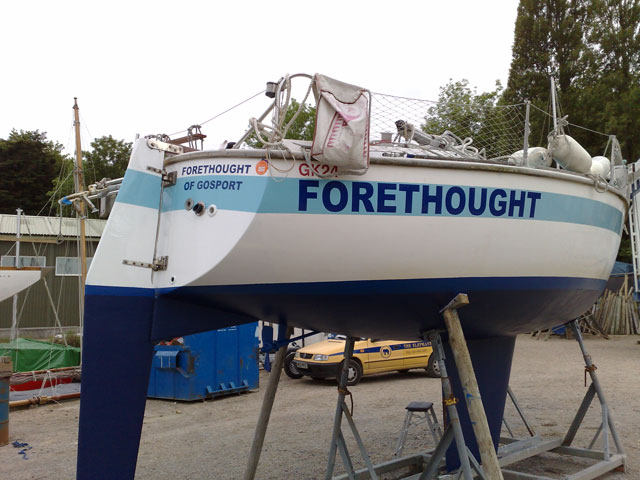
You can see in the picture the extra shiny Toplac near the transom just
above the boot topping stripe.
Day 6: Tuesday
Tried
to get mast spares , there is now nothing left for 30 year old Proctor
masts. Made up a spreader end using 5mm aluminum sheet. Actually
things like Proctor main halyard sheaves are the same size as modern
Selden ones but the people who sell masts seem to be too stupid to read
their own catalogues which can be found online.
Day 7: Wednesday
Played
around with DIY anodizing using 60 volt power supply , kitchen
chemicals
and a lot of care against electrocution. (at 25 volts I could feel the
tingle with wet hands) . Thickness of anodizing film depends on
polarizing voltage like aluminium electrolytics where the film is thick
enough to block the working voltage. In this case the current
never dropped as there were too many holes in the oxide layer or I was
doing it too fast, and I was in danger of boiling the electrolyte with
the 60 watts of power going into it...
Day 8 : Thursday :
Fitted spreader end,
took first pass at main halyard sheave by filing it down to sort
of circular. Pulled the wire for the new wind instrument down the mast
after false starts caused by the last piece of string that holds the
wiring bundle together inside the mast still being there, stopping the
10 mm diameter plug on the end of the cable from going down the mast.
Very frustrating with going back and forwards 12 metres to pull on
different strings.
Day 9: Friday:
Non-delivery of rigging as wrong parts sourced from supplier to the
riggers.
Day 10: Saturday:
Went
to the original Aladdins Cave Foulkes chandlery barge and eventually
found a sheave with a smaller hole for the main halyard. Drilled out
the hole and then fitted the sheave and started replacing
the bolts holding the chainplates to the deck as there was some sign of
corrosion. Discovered that Force 4 dont do all the sizes of M8 bolts
and so I had to put them all back. Some are a bit corroded, but
strangely shiny. Ordered relevant bolts from A2A4.
Day 11: Sunday
Went for a walk in the New Forest with ex-NXP colleagues ending in a
meal at a pub.
Day 12: Monday
Day 13: Tuesday
Still no rigging
Day 14: Wednesday
The
rigging suppliers computer system is down. 'no point in going to
Chandlers Ford to ask for the parts as they wont be able to do
anything'' I am starting to consider asking for the old rigging
back to be re-fitted as I have now missed another Wednesday evening
racing owing to problems in the rigging department.
The new
stainless bolts have arrived so I can fit them tomorrow, hopefully the
rigging will appear and I can fit that back to the mast in the slight
hope of getting the boat back on Friday.
Then all that will be
left if the mast gets back in ever is wiring through the cables for the
new wind transducer and powering up the instrument bus from autopilot
through to wind transducer.
Day 15: Thursday
The riggers phone to tell me the rigging is on course for Friday AM. So
is the high tide so it all comes together at the Elephant Boatyard's
mast stepping and unstepping barge. I fitted the nice new bolts so I
wont be worrying about crevice corrosion while broaching in the RTI .
Hopefully I will get the boat back on Saturday and then fit the
masthead wind instrument and thread a couple of wires for it through
the lockers.
Round the Island
Fixing the mainsheet broken during the RTI
We pulled a fitting off the boom and so had to use the spare fitting.
The end of the boom was so corroded I decided to cut off the jagged
metal , file down the mess and fit a webbing strop instead around the
end of the boom.
Mike James June 2nd 2009


![[GK24 logo]](gk24logo.gif)

 On one tack as we were coming onto the layline for a windward mark, the
bronze snap shackle holding the bottom of the mainsheet on the
traveller (quick release for cockpit living in harbour and use as a
crane hook) got twisted around the traveller and was opened
and
then the
operating pin was snapped off. Fortunately, I had left a couple of
shackles close to hand inside the cabin.
On one tack as we were coming onto the layline for a windward mark, the
bronze snap shackle holding the bottom of the mainsheet on the
traveller (quick release for cockpit living in harbour and use as a
crane hook) got twisted around the traveller and was opened
and
then the
operating pin was snapped off. Fortunately, I had left a couple of
shackles close to hand inside the cabin.



